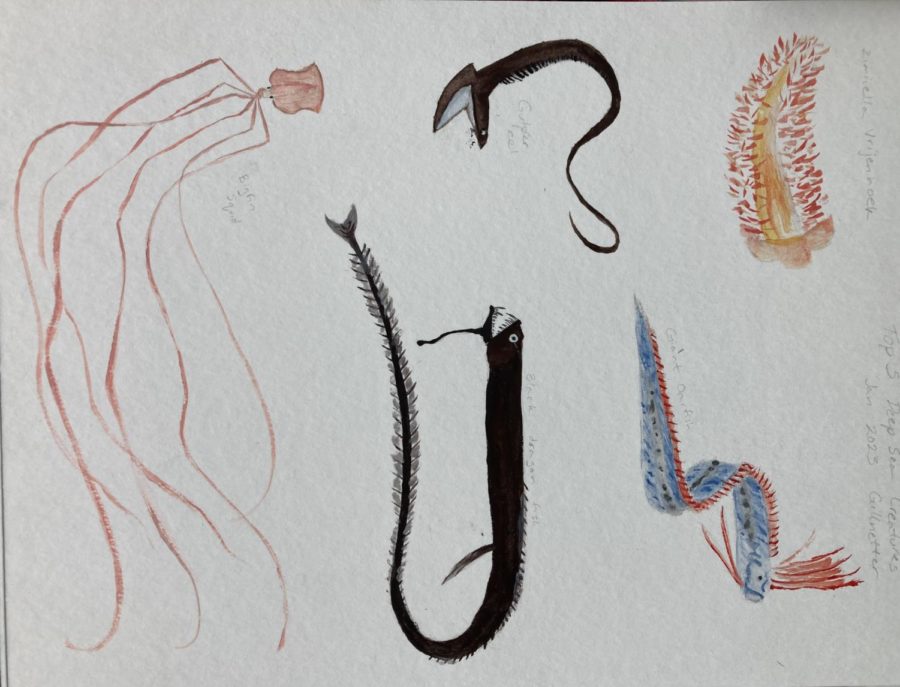Top five deep sea creatures
Gillnetter’s Evelyn Porter has a passion for underwater sea life. Here are her top five most interesting creatures of the depths.
Evelyn Porter’s watercolor depiction of The Gillnetter’s top five deep sea creatures.
January 26, 2023
1. Ziminella Vrijenhoek
The top creature on this list is shrouded in mystery. It lives in the deep, deep sea, and thus, there is very little information about it. We do know, however, that this is a species of sea slug. They were discovered in the early 2000s on a Blue Whale carcass, and they likely grow to be about 20 mm (roughly ⅘ of an inch). The aspect of this little slug that sent it to the top of the list, though, is something very different. Pure visual bias wins the day here, and the Ziminella Vrijenhoek is at the top of this list because of its vibrant orange color and soft looking cerata. This little nudibranch looks very sweet and extremely cuddle-able.
2. Giant Oarfish
Our number two creature is not quite so cuddly. The Giant Oarfish finds habitable waters nearly world-wide, the only excluded waters being polar regions. The oarfish is very narrow, often likened to a ribbon, and a dorsal fin along its whole length. The Giant Oarfish is the world’s longest bony fish, reaching up to 8 m (26 ft) in length. Although first thought to be quite rare, new technological advances indicate the Giant Oarfish is likely quite common. However, seeing as deep sea habitats are inhospitable for our meager human bodies, it is unlikely the average beach-goer will find one.
3. Gulper Eel
The Gulper Eel, also commonly known as the Pelican Eel, is on this list not for size or color, but for general strangeness. While the eel itself has an average length of 0.75 m (2.5 ft) and is rather plain, dark brown and eel-like, its jaw is very peculiar. The mouth is loosely hinged low on the head of the eel, taking up nearly one quarter of its entire length. Because of this unusual feature, the Gulper Eel can swallow fish larger than itself whole. Gulper Eels are found in almost entirely temperate to tropical deep sea waters, even being delicate enough to become damaged upon leaving the intense pressure there.
4. Black Dragon Fish
Black Dragonfish (Idiacanthus Atlanticus) is the opposite of our number one, the Ziminella Vrijenhoek. Where the orange nudibranch is cute and cuddly looking, the Black Dragonfish is barbed, spiny, and dark. However, the Black Dragonfish is still a manageable size, with females being up to 40 cm (16”) and males averaging 5cm (2”). Despite their slightly creepy appearance, these fish have some neat characteristics of their own. Their main feature is their subtle bioluminescence. One might even go as far as to say that their bioluminescence is cooler than most, because the light is visible to the fish making it. While many other deep sea creatures with bioluminescence use their unique ability to lure in prey, the Black Dragonfish uses the light they created to aid them in their hunt. This light is barely visible to the human eye, sadly, being nearly infrared.
5. Bigfin Squid
The Bigfin Squid, not to be confused with the Bigfin Reef Squid, is also on here for a creepy look rather than a cute one. The squid is rarely seen, and can cause quite a fright when it is perceived, bearing a striking resemblance to an extraterrestrial being. This resemblance is often mentioned because of the very long arms and tentacles wielded by the squid. Ranging from 4 to 8 m (13-26 ft), nearly all of the length of the squid comes from its appendages. Unlike any other non-extinct squid, its arms and tentacles are the same length, with almost no physical differences. The most striking feature of this squid is the way that its appendages are held perpendicular to its body, creating very unusual elbows.











![The GHS/MERHS senior cross country runners pose together on Senior Night. [Photo courtesy of Manchester-Essex Athletics]](https://thegillnetter.com/wp-content/uploads/2025/10/Screenshot-2025-10-10-at-11.18.29-AM.png)



















